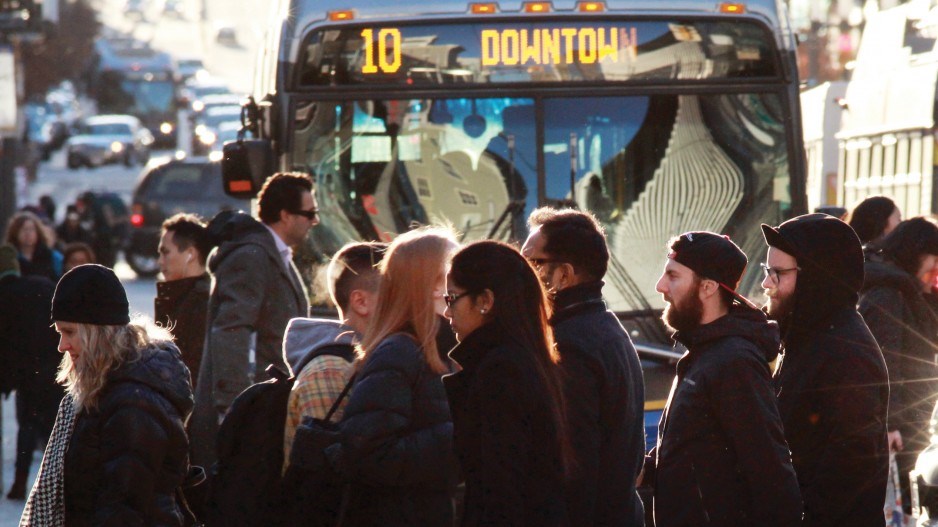(This story has been corrected. An earlier version stated the $1.6 billion was in fare and tax increases. That is the expected increase in revenue from increased ridership.)
TransLink will raise an additional $1.6 billion through increased ridership and $40 million in increased transit fares, property tax hikes, parking lot sales tax increases, and new development costs charges on residential development to help pay for what has been called the single largest investment in public transit in B.C. history.
As a result, TransLink hopes to see construction start on the new Broadway extension to the Millennium Line and new light rail system to Surrey in 2019 and 2020, and see an additional 900,000 hours of bus service added.
“This is the largest transit funding announcement in B.C. history,” Burnaby Mayor Derek Corrigan, chairman of the Mayors Council on Regional Transportation, said at a press conference Friday March 16.
The additional funding comes from four primary sources - $10 million each from fare increases, property tax hikes, and increased off-street parking lots sales taxes.
Another $7.5 million will come from new DCC charges on new development, which will require new legislation to be passed; $2.5 million will come from commercial revenues, the source of which has not been identified.
The new revenue is intended to cover TransLink’s share of $7 billion worth of public transit funding, to which the federal and provincial government’s have each committed $2.2 billion.
The new fare and tax increases include:
• a 2% fare hike for transit users, starting in 2020;
• a $5.50 annual increase in property taxes for the average household;
• a 3% increase in TransLink’s tax rate on parking lots (24%, up from 21%); and
• $300 to $600 per unit in new DCCs for new residential development.
Regional mayors have, for years, resisted various proposals for raising local revenue to pay for much-needed public transit investments.
But they have been under pressure to come up with a new funding model to leverage roughly $4.4 billion that has been committed to Lower Mainland public transit by the federal and provincial governments.
“It took considerable compromise on the part of all of the mayors,” Corrigan said. “Everyone had a problem with accepting some elements of the plan.
“But when you’ve got the kind of money that we’ve got on the table from the provincial government, and the money that the federal government’s bringing to the table, it would be foolish for us not to be prepared to make the necessary compromises to get that money into the Lower Mainland.
“While further discussion over the next two months is needed to finalize these new rates, it is a modest and balanced increase that will generate the region’s remaining share of the funding needed to deliver the Phase 2 plan.”
Big-ticket transit projects include:
• the Broadway extension to the Millennium Line;
• a new light rail system that will connect to Surrey, Newton and Guilford;
• upgrades to the existing Expo-Millennium Line to expand capacity.
The plan also includes a significant increase to bus service – an 8% increase in bus capacity that will add 900,000 hours of service per year and require the hiring of hundreds of new bus drivers. The region’s HandyDART service will also be beefed up.
“We are adding almost as much bus service as delivered in total by BC Transit in the rest of the province,” Corrigan said.
Corrigan credited the John Horgan NDP government for working with regional mayors to get an agreement on funding. In addition to matching federal capital funding, it also agreed to help TransLink cover a funding gap.
“We’ve also committed to reducing TransLink’s fiscal pressures by $30 million, which will help the region get vital transportation projects under way as soon as possible,” said Selina Robinson, the provincial minister responsible for TransLink.
“The province doubled down,” Corrigan said. “Not only did they make a commitment to 40% of all the capital expenditures for this system, but they also helped to close that gap with us.”
The $7 billion in funding represents Phase 2 of a two-phase transit improvement plan. Phase 1, already under way, included the hiring of 500 new bus drivers and four new B line routes.
TransLink CEO Kevin Desmond said he hoped to see construction on the Broadway extension and the first 10 kilometres of the planned 27-kilometre light rail system to Surrey in late 2019 or early 2020.
If timelines are kept, he expects top see the Surrey light rail transit system operational by 2024, and the Broadway extension by 2025.
Corrigan said the plan announced Friday still needs to be approved by the Mayors Council in June, but also said that it had already received unanimous support by the region’s mayors.
Asked if the new suite of fare and tax hikes means the Mayors Regional Council is abandoning mobility pricing, Corrigan said it wasn't. Mobility pricing is a debate Corrigan said he expects to go on for a few years.
"We can't look to that to be a source of funding for the transit improvements that we need right now," Corrigan said. "We need to do this immediately."




